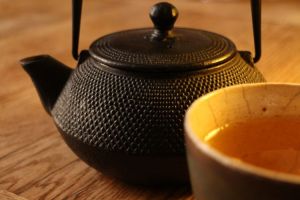Autumn will be here soon, and we at Dominion Tea can’t help but feel excited! Crisp weather, colorful leaves – and, of course, the return of some of our favorite cozy flavors. And while so many of the seasonal beverages are tasty, we wanted to shine a special spotlight on one delicious remedy, the unsung hero of cold and flu season: the hot toddy.
If you haven’t tried a hot toddy when you’re under the weather, you’re missing out. This historic drink has a long reputation for soothing sore throats and stuffy heads. However, what exactly goes into a hot toddy is a matter of debate. Some start with black or herbal tea, while others just use hot water. Some call for sugar, some honey. Some may use whiskey, some brandy, some no alcohol at all… the list goes on. But all variations aside, the essence of the drink remains the same: a tea or water base flavored with sweetener, citrus, and warming spices, often (but not always) bolstered with a shot of alcohol.
So when and where can we find the true origins of the fabled hot toddy? One popular theory holds that it may have begun its life in British-occupied India during the 18th century, when trade brought the traditional palm wine known as tadi (or toddy) to European attention. This drink was often mixed with sugar and warming spices, evolving over time into the hot toddy we know today.
Other theories speculate that the hot toddy was first invented in Scotland. Named for Edinburgh’s Tod’s Well, the city’s primary water source, this toddy began as a bracing mixture of Scotch whisky with hot water and spices to fend off the cold of northern winters. Still others claim that the drink may be credited to 19th century Irish physician Robert Bentley Todd, who was said to have often prescribed his patients a hot drink mixture consisting of water, sugar, cinnamon, and brandy.
Regardless of where it came from, the hot toddy still retains a respected place among our favorite seasonal drinks. Its endless variations are the perfect way to mix and match flavors just the way you like. We favor a cozy and soothing blend of caffeine-free honeybush, warming spices, and lemon peel in our toddy base blend – perfect with a dash of honey and whiskey for those blustery nights. What’s your favorite way to enjoy a hot toddy?
By: Jen Coate



 It’s amazing to see how fast coronavirus has changed everything. Across the country, Americans are settling into new social isolation routines, which can be difficult and frightening, especially for those of us who enjoy long conversations with friends and family over a pot of tea. But even though times are stressful, we at Dominion Tea want to remind you to take comfort in the little things that can make it all more bearable: a healthy walk outside, a phone conversation with a loved one, or – of course – a comforting cup of your favorite tea.
It’s amazing to see how fast coronavirus has changed everything. Across the country, Americans are settling into new social isolation routines, which can be difficult and frightening, especially for those of us who enjoy long conversations with friends and family over a pot of tea. But even though times are stressful, we at Dominion Tea want to remind you to take comfort in the little things that can make it all more bearable: a healthy walk outside, a phone conversation with a loved one, or – of course – a comforting cup of your favorite tea.



